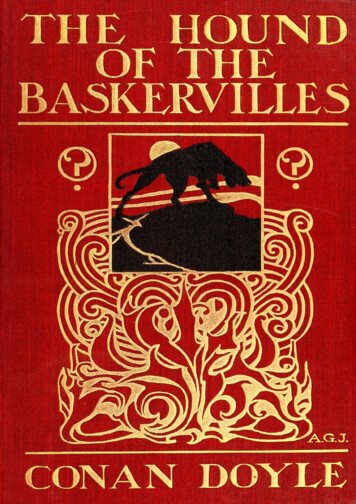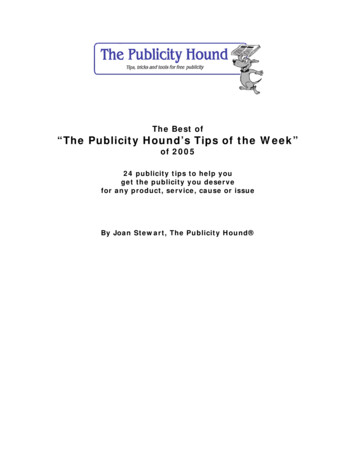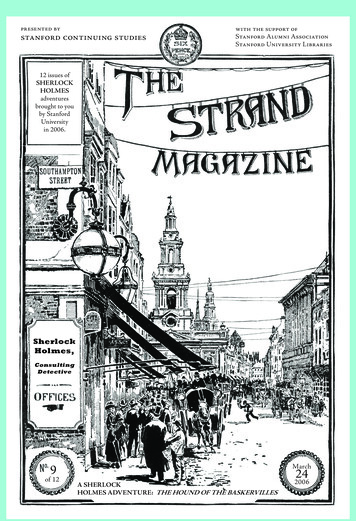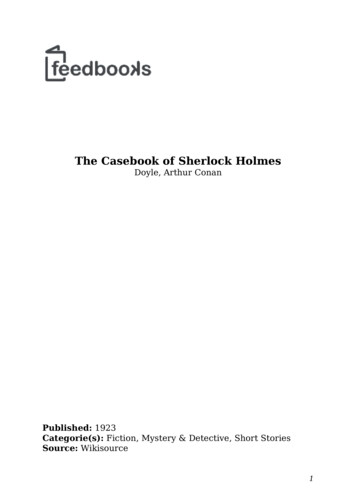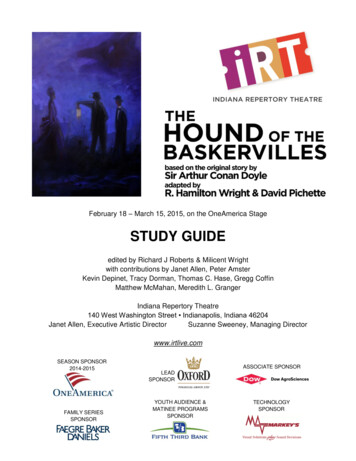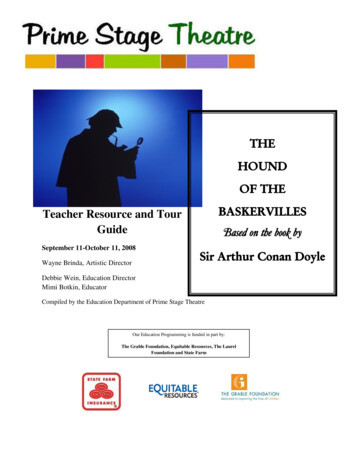
Transcription
THEHOUNDOF THEBASKERVILLESTeacher Resource and TourGuideSeptember 11-October 11, 2008Wayne Brinda, Artistic DirectorBased on the book bySir Arthur Conan DoyleDebbie Wein, Education DirectorMimi Botkin, EducatorCompiled by the Education Department of Prime Stage TheatreOur Education Programming is funded in part by:The Grable Foundation, Equitable Resources, The LaurelFoundation and State Farm
Introduction & How to Use this GuideThis guide was based on continual research conducted by the Prime Stage Artistic Director on reluctant andstruggling readers and the results of a study Prime Stage conducted with students and teachers from two schools thatexplored how to “Connect kids to literary classics” through the theater and in the classroom. The study‟sparticipants made the following significant recommendations:Provide resources that help students connect the literature, the play, and their livesProvide resources that help teachers create engaging and enriching experiencesChange the name of the curriculum or study guide to a “Resource and Tour Guide”Introduce the world of literature and the world of the play to help students and teachersadequately prepare for the experience of seeing literature come to life on stageReluctant and Struggling Readers- Much research is conducted on students designated as reluctant and strugglingreaders. There are many websites devoted to this subject; links to some of these can be found on the educationpages of our website. In summary, reluctant readers want choice; help navigating through complex literature, andexperiences to share their responses with peers and adults (Baker 2002; Gambrell 1996; Ivey 2002; Reeves 2004;Sumara 2002; Tovani 2001). Struggling readers need support with vocabulary, “chunking” ideas rather thandecoding words, visualizing, expressing what they see, and how to ask questions as they read.This guide addresses those concerns by providing a range of information that reluctant readers can choose toexplore, read, and discuss as they discover The Hound of the Baskervilles. For struggling readers, complex orunfamiliar vocabulary is highlighted to help you create “word walls” or other strategies that address comprehensionand, ultimately, enjoyment of the literature.Visualization, Imagery & Imagination- Wilhelm (2004), in Reading is Seeing, proposed addressing visualizationcan:Heighten motivation, engagement, and enjoyment of readingEnhance comprehension of both narrative and expository testsStimulate prior knowledgeProvide a “template” for more sophisticated strategies, such as inferringDevelop awareness of one‟s reading processes (metacognition)Increase reader‟s ability to share, critique, and revise what is learned with othersImprove test scoresImagery- Recreating in one’s mind the sights, sounds, smells, tastes, and touches described by an author (Clewell2006). Pictures in this guide can help your students visualize and describe what they read and see.How to use this guide- This guide is not a collection of lesson plans. While you will find lesson suggestionsthroughout the guide, the material is designed to provide material that will enrich your lessons with students,encourage them to read the literature, improve their vocabulary with words highlighted in bold that may beunfamiliar to them, and comprehension of the literature, and stimulate an enjoyment of reading and exploringliterature. The guide is designed to help you find ways of helping your students see the literature, not just as wordson pages, but as vibrant images, characters, settings, conflicts, and ideas that relate to their lives today.We hope you find this Resource and Tour Guide useful, helpful, and enjoyable.Thank you.2
Statement of Prime Stage Theatre’s Commitment to LiteracyLiteracy, in relation to adolescent learners, is defined by Jetton and Dole (2004) as constructive,fluent, strategic, motivated, and a lifelong pursuit.Theater has demonstrated its effectiveness as a strategy to teach reading, speaking andlistening skills, focus, discipline, teamwork and patience as well as any sport. On the middleschool and high school level, it helps teachers build a better understanding of the world, anenjoyment of English, languages, and reading. Good teachers strive to help their students connectto the literature by connecting it to their own world. This puts the literature into a framework forstudents to understand and appreciate. Good actors bring the characters from the pages to life,giving them full dimension, providing a multi-sensory experience, allowing students to "see" andvicariously "live in" the literature. The mission of Prime Stage to 'Bring Literature to Life'provides the best of both disciplines. Prime Stage Theatre has the privilege, through generousfunding from local foundations, to realize its mission of addressing adolescent literacy throughtheatrical productions and educational programs. Our distinctive Adopt-a-School Program,Resource Guides, Teacher Workshops, and Mentor Program make theater accessible to middleschool and high school educators, students and their families. Through theatre, students connectliterature to their lives, and to the larger community in which they live.Prime Stage, where seeing is believing!A word about the lessons:Our Education Resources include activities that we suggest you do with your class toenhance your fieldtrip to Prime Stage. Some activities and lessons are appropriate for doing inclass before attending the play, on the bus ride to the theater, and after you return to school.The lessons, which have been designed by fellow teachers and culled from on line resources,meet PA Humanities and National Standards for Arts Education. Please let us know whichsections are most helpful as you prepare your students for a fieldtrip to Prime Stage.Please view our website and use us as a resource for teaching literature in your classrooms.Prime Stage, Where Literature Comes to Life! www.primestage.comWayne Brinda, Ed.D, Artistic Director and Founder of Prime Stage TheatreDeborah H. Wein, Education DirectorMimi Botkin, EducatorPlease note: This guide is a compilation of information obtained from numerous websites.We have noted all the websites used in each section, and also compiled a list at the end ofthe guide.3
The Author: Arthur Conan DoyleArthur Conan Doylewas born 22 May1859 in Edinburgh, thecapital of Scotland. Heearned his medical degree from the University of Edinburgh andpracticed as a doctor briefly. His first short story was published in1879 (not about Sherlock Holmes). The first novel containing thecharacter of Sherlock Holmes was published in 1887. A Study inScarlet appeared in Beeton's Christmas Annual, a popular magazineof the time.Conan Doyle was the author of more than 50 books,including historical novels, his most famous being The WhiteCompany. He also loved to write science fiction: The Lost Worldand other novels of Professor Challenger, domestic comedy,seafaring adventure, the supernatural, poetry, military history, andmany other subjects.In 1893, the author grew tired of the character and "killed" Sherlock Holmes by reportinghis apparent death in "The Final Problem", the last story of The Memoirs of Sherlock Holmes. Hewanted to devote time and attention to his "more serious" writings. Holmes was briefly broughtback in The Hound of the Baskervilles in 1901, and then revived in "The Empty House", 1903,and subsequent tales.The famous writer was knighted ("Sir Arthur") in 1902 for his work in war propaganda(particularly the pamphlet The War in South Africa: Its Cause and Conduct) -- and, some said,because of the publication of The Hound of the Baskervilles.His life-long interest in psychic matters led him to acknowledge Spiritualism as his faith.He spent the years from 1918 to his death (7 July 1930) preaching Spiritualism around the worldand writing books and pamphlets in support of it (The New Revelation, 1918). Spiritualism‟sprincipal beliefs included the survival of personality after death and the possibility ofcommunication (through mediums) between this world and the next.Conan Doyle was a constant writer of letters to the editor and crusader for social reforms.Of special interest to him: criminal justice (he took a personal role in the George Edalji andOscar Slater cases), military strategy (though he never served in the armed forces), public health,sports (cricket, boxing, Olympics), divorce law reform, Belgian exploitation of the Congo. Hetwice ran unsuccessfully for Parliament.*Standard biography: John Dickson Carr, The Life of Sir Arthur Conan Doyle, 1947. Recent and comprehensive: Martin Booth, The Doctor, theDetective & Arthur Conan Doyle, a Biography of Arthur Conan Doyle, 1997.4
The Complete Works of Sir Arthur Conan DoyleSherlock Holmes novelsA Study in Scarlet (1887)The Sign of Four (1890)The Hound of the Baskervilles (1902)The Valley of Fear (1915)Sherlock Holmes short story collectionsThe Adventures of Sherlock Holmes (1892)The Memoirs of Sherlock Holmes (1894)The Return of Sherlock Holmes (1905)His Last Bow (1917)The Case-Book of Sherlock Holmes (1927)The Complete Sherlock Holmes Short Stories (1928)Professor Challenger StoriesThe Lost World (1912)The Poison Belt (1913)The Land of Mist (1926)The Disintegration Machine (1927)When the World Screamed (1928)The Professor Challenger Stories (1952)Historical NovelsMicah Clark (1887)The White Company (1891)Refugees (1893)Rodney Stone (1896)The Exploits of Brigadier Gerard (1896)Uncle Bernac (1896)The Adventures of Brigadier Gerard (1903)Sir Nigel (1906)PamphletsThe War in South Africa: Its Cause and Conduct (1902)The Case of Mr. George Edalji (1907)The Case of Oscar Slater (1912)Spiritualism and Rationalism (1920)The Early Christian Church and Modern Spiritualism (1925)Psychic Experiences (1925)Spiritualist WorksThe New Revelation: or, What Is Spiritualism? (1918)The Vital Message (1919)Spiritualism: Some Straight Questions and Direct Answers (1922)The Wanderings of a Spiritualist (1921)The Case for Spirit Photography (with others) (1922)The Coming of the Fairies (1922)The Spiritualists Reader (Editor) (1924)The History of Spiritualism (vol. 2) (1926)Pheneas Speaks: Direct Spirit Communications (1927)What Does Spiritualism Actually Teach and Stand For? (1928)The Edge of the Unknown (1930)5
The Novel: The Hound of the BaskervillesPlot SummaryThe Hound of the Baskervilles is one of the most famous and admired detective stories everwritten. Published in 1901 and 1902, it originally appeared in nine monthly installments in TheStrand magazine. Like Dickens's serialized novels of the same era, each installment ended with asuspenseful "cliff-hanger" that kept author Arthur Conan Doyle's audience clamoring for more.In the story, the old and noble Baskerville family is threatened by a curse: "A great, black beast,shaped like a hound, yet larger than any hound that ever mortal eye has rested upon" terrorizesand kills any family member who comes to live at the Baskerville estate. As the story opens, thehound seems to have claimed his latest victim, Sir Charles Baskerville. Sir Charles's nephew,Henry, the new heir to the estate, is poised to take up residence the next day. A friend of thefamily, Dr. Mortimer, comes to consult the famous Sherlock Holmes in his rooms at 221b BakerStreet, though he confesses he doesn't know if the case is more suitable "for a detective or apriest." The first installment of the novel originally ended as Dr. Mortimerexplains:".One false statement was made by Barrymore at the inquest. He said that there were notraces upon the ground round the body. He did not observe any. But I did -- some littledistance off, but fresh and clear.""Footprints?"6
"Footprints.""A man's or a woman's?"Dr. Mortimer looked strangely at us for an instant, and his voice sank almost to a whisper as he answered: "Mr.Holmes, they were the footprints of a gigantic hound!"Into this atmosphere of lonely moors, ancient secrets, deadly threats, and ghostly apparitionscomes the supremely rational Sherlock Holmes -- a man described by his friend Watson as "themost perfect reasoning and observing machine the world has ever seen." Piece by piece Holmesand Watson solve the mystery and find the culprit. In the end, they reassure the characters in thenovel (as well as Conan Doyle's Victorian readers), that behind the threat of a supernatural"hound of hell" is a perfectly scientific uide *www.thebestnotes.com/booknotes/Hound eptual/hound.htmLIST OF CHARACTERSMajor CharactersMr. Sherlock HolmesThe protagonist of the story. He is a detective and skeptic of the supernatural superstitions aboutthe hound and determined to find the true evil behind the case. His powers of deductivereasoning and knowledge of human character allow him to get the most out of each clue, andeventually solve the case.Dr. WatsonHe serves as a secondary protagonist to Holmes and narrator of the story. Though not nearly asskilled in the art of detecting as Holmes, Watson is nonetheless invaluable; his reports allowfurther information to be relayed while Holmes remains in secrecy. These reports focus on howWatson has followed up on clues and kept an eye on SirHenry‟s safety.Mr. Jack StapletonThe antagonist of the story, Stapleton is the one who let thehound loose on Sir Charles, and attempted to likewise kill SirHenry, in his pursuit of the Baskerville family inheritance(Stapleton is the son of Rodger Baskerville). While hisinterest in entomology is not fabricated, his name andsituation are, such as the passing off of his wife as his sister,Miss Stapleton. His similar appearance to Hugo Baskervillereveals his motive in the crime, and, when he realizes Holmeshas set a trap for him, he runs to his death.The Baskerville family (Sir Henry, Sir Charles, and SirHugo)Hugo Baskerville‟s actions led to the legend of the hound ofthe Baskervilles, which prevents any member of the familySherlock Holmes and Dr. Watson7
from going out on the moor at night under threat ofdeath. Sir Charles is a kindly old man whose death,which seems to coincide exactly with the legend,brings in Sherlock Holmes to investigate. Sir Henry isthe heir to the fortune whose life is endangered whenhe goes to live in Baskerville Hall.Minor CharactersMiss StapletonShe is a beautiful woman from South America, whomSir Henry falls in love with, not knowing she isactually married to Stapleton. She tries to save thebaronet several times, by sending him the warningnote in London and in person in Devonshire.Dr. MortimerHe is the country doctor who brings the case to theattention of Holmes and Watson. In doing so, heforgets his walking stick at their apartment; this provides an opportunity to introduce the readerto detective techniques, as Holmes and Watson draw out a profile of him based on the stick. Heis also the one to tell Watson that Laura Lyons is the woman whose initials are at the bottom ofthe burned letter.The Barrymores (John and Eliza) and SeldenBarrymore falls under suspicion early on, with his black beard (like the man in the cab) andsuspicious behavior, suspiciously regarding the telegram and nightly trips to the empty roomwith the candle. Mrs. Barrymore reveals the reason for the latter-her brother is the escapedconvict Selden and they have been taking food to him. Selden dies when the hound mistakenlypursues him in some of Sir Henry‟s old clothes.CartwrightHe is the young boy who Holmes employs as an assistant. He is sent to look for the cut-up copyof the Times in the hotel trash and is taken out to Devonshire to run errands for Holmes.Mr. Frankland and Laura LyonsFrankland is a neighboring man who spends his time with lawsuits and astronomy, and whosemajor part in the story is pointing out to Watson the boy carrying food to what he believes to bethe convict. Laura Lyons is his estranged daughter, who was manipulated by Stapleton intosending the letter to Sir Charles and then not keeping the appointment.LestradeHe is the Scotland Yard detective that normally works with Holmes and Watson. He comes outto Devonshire when Holmes sends him a telegram requesting him to do so.8
The HoundA fierce hound bought by Stapleton and kept locked up out on the moor,except when used to kill Sir Charles, Selden, and (almost) Sir Henry. Itscries and the sight of it covered in phosphorus help keep the family legendalive.ThemesSolving a murder and preventing another is the major theme, which can then be expanded intothe themes of crime, protection, and detection. In the novel, crime is executed by evil (or, as it isbelieved, supernatural) forces, especially in the form of Stapleton. Driven by a desire for moneyand power, he is willing to dehumanize those around him to the same state as his specimens.Selden is another, smaller example of crime. He has committed murder as well but for variousreasons he does not seem as bad, thus eluding that there are different layers of crime.Holmes‟s main role in the story is protect good from evil; that is why he has been hired in thefirst place, to ensure Sir Henry‟s safety from the Baskerville curse. He is also concerned withWatson, inquiring several times to make sure that his revolver is close at hand. One of the mostdramatic moments for the theme of protection comes when Watson and Holmes hear the houndpursuing Selden and then, seeing the distorted body, mistake it for Sir Henry. Holmes isunderstandably distraught at the thought of his client dead, knowing that with that the case willbe considered a failure even if they catch Stapleton.By Holmes‟s occupation and the nature of the book, it is clear that detection will be an importanttheme. It also includes the juxtaposition and overlapping of crime and science, and, to a lesserdegree, family lines. The former can be seen primarily in the characters of Holmes, a detectivewho must be aware of the world as much as any scientist, and Stapleton, a naturalist whocommitted murder. Family lines play a role because it is the realization of the connectionbetween Stapleton and Sir Henry through bloodlines that provides the last of the informationneeded to figure out the case (motive).MoodThe phrase “gloom and doom” can be aptly applied to the mood of the novel. The Hall seems adepressing place from the start and the moor in general offers little to combat those feelings withthe marshy land, rain, and fog. There is also the threat of the hound, whose occasional cries andsightings instill an unnerving fear in those around.In the beginning of the book, there is also a sense that Holmes might not be able to solve thecase. When his attempts at getting further information are foiled and he himself admits that it is aworthy opponent, the mystery seems overwhelming. However, as Holmes gets a stronger andstronger hold on the case, the main state of emotion is that of hurriedness, the need to solve thecase before Stapleton acts again.Literary/Historical InformationThe major historical force behind Conan Doyle‟s beliefs and the novel is the Spiritualismmovement. Throughout the case, everyone, except for Holmes, comes to think, at least for sometime, that the hound is supernatural. The closest Holmes himself comes is when he says at the9
start of the case that while he has previously dealt with evil, taking it on like this, might prove tobe more than he can handle. It is not a supernatural force in the end though, interesting since thescientific Conan Doyle (like Dr. Mortimer) believed in Spiritualism.Several other historical aspects of the novel include the emphasis on lineage, the emphasis onmoney and power, the contrast between rural and urban life, and the increasingly important roleof science. While many of these were not new features of life at the time, the IndustrialRevolution had done much to bring them out, especially the feelings of dehumanizationassociated with the pursuit of money.Symbolism/Motifs/SymbolsThe HoundThe hound that haunts the Baskerville family because of adisreputable ancestor primarily represents Stapleton. He tracksdown and kills his relatives, as a result of his ancestor, RodgerBaskerville (from whom he inherited not only a claim in the Baskerville line but also hispersonality).The Barrymores have a hound of their own in a way in Selden the convict. Like the hound, healso lives out on the moor, has a wild appearance, a glow associated with him (candlelightinstead of phosphorous), and is also dead by the end of the story.Family PortraitsThe family portrait of Hugo that enables Holmes to figure out the motive symbolizes theconnection between past and present. The Hall itself has more modern additions attached to theold ones, and on the moor, there are huts from the time of Neolithic man not far from the housesof the people living now (at the time of the case).It is also representative of the Baskerville inheritance. Aside from the estate and title, there isalso the curse. Sir Charles, and Sir Henry to a slightly lesser extent, lived in fear of the hound,because they were descendents. Stapleton got his looks and personality from Hugo Baskerville aswell as his father.The MoorThe surrounding of the moor compliments the atmosphere ofgloom and doom that permeates throughout the story; it wouldtake away much to have the setting in a sunny, rolling fieldinstead. Besides being essential to the mood, the moor alsolends itself to the plot, providing sufficient hiding places forHolmes and the hound, and taking care of Stapleton.10
Moorland or moor is a type of habitat found in upland areas, characterized by low growingvegetation on acidic soils. Moorland nowadays generally means uncultivated hill land (such asDartmoor in South West England), but the Anglo-Saxon „mŏr‟ also refers to low-lying wetlands(such as Sedgemoor, also http://images.google.com/imagesRed HerringA classic of the mystery/detective genre, the redherring throws us off the right trail. In Hound, thelargest red herring is the convict. After all, whobetter to pin a murder on than a convictedmurderer!He was in a highly nervous state. Something was preying upon his mind.As you value your life or your reason, keep away from the moor.It‟s an ugly business. The more I see of it, the less I like.I don‟t know whether it‟s a case for a detective or a priest.I had no idea such a sum was involved. It is a stake for which a man mightwell play a desperate game.You must not go alone. Some great misfortune will befall you if you do.No wonder my uncle felt as if trouble were coming in such a place as this.It‟s enough to scare any man.Did you happen to hear someone, a woman, sobbing in the night?Go back! Go straight back to London instantly. For God‟s sake, do as I askyou. Go back and never set foot on the moor again.I suppose the kindest thing would be to put you out of your misery.Great Quotesfrom“Hounds”Use one of thesequotes as aprompt to haveyour studentsstart writingtheir ownmystery story!11
KEY FACTSTitleThe Hound of the BaskervillesAuthorSir Arthur Conan DoyleDate Published In book form-1902 (serialized in The Strand in 1901)Meaning of the TitleRefers to the Baskerville family legend; a giant hound killed the evil Hugo and is said to continue dooming the line.Stapleton, a Baskerville, owns a hound, which he uses to kill Sir Charles and make an attempt to do likewise to SirHenry. Thus it could also refer to Stapleton as the family hound.SettingEngland-London and Devonshire (Baskerville Hall, Merripit House, Coombe Tracey, and out on the moor,including Grimpen Mire and the Neolithic dwellings)GenreMystery/ suspenseProtagonistMr. Sherlock Holmes and Dr. WatsonAntagonistStapleton (previously known as Rodger Baskerville and Vandeleur)MoodGrave (the characters‟ attitudes) and dismal (the physical surroundings of the place)Point of ViewFirst person limited (all from Watson‟s perspective)TensePast tenseRising ActionIt begins in London when Sir Henry receives the message warning him and has his boot stolen. When Holmes‟sattempts at solving the case in London turn out to be dead-ends, they go out to the moor. Events there includemeeting the neighbors, hearing the sound of the hound, the talks with Mrs. Lyons, the events surrounding theconvict, and ends with Watson, Holmes, and Lestrade waiting for Sir Henry.ExpositionThe exposition is in the first three chapters when Dr. Mortimer visits and lays out the situation. It is here that welearn about the legend, the mysterious death of Sir Charles, and the issue of the safety of the arriving heir.ClimaxThe climax occurs when the hound appears out of the fog in pursuit of Sir Henry.OutcomeHolmes shoots the hound to death. They are unable to find Stapleton, who likely ended up in one of the bogs just offthe path and, unable to free himself, died.Major ThemeSolving a murder and preventing another (could be expanded to be protecting good from evil)Minor ThemesCorruption in pursuit of money and power, evilness and dehumanization (the convict‟s savage appearance and death,Stapleton‟s mistreatment of his wife and others), science/ crime (naturalist that murders, detective that observesworld), family line (inheritance of physical and personality characteristics in Rodger Baskerville, obligation ofBarrymores to Selden, neglect of daughter by ide12
Victorian London: The Era of Sherlock HolmesAlthough Arthur Conan Doyle wrote about Holmes over a 40-year period that spanned threedistinct eras in British life (Victorian, Edwardian, and Georgian), in the Holmes stories it isalways the late Victorian era. Holmes himself so completely embodies the values of this era, infact, that he is regarded by many as "the perfect hero for his age."A man who believed in reason above all, Holmes was ideal for his time -- a time in whichscience challenged long-held beliefs and the status quo was threatened by social and economicchanges. Charles Darwin's 1859 The Origin of Species changed the Western world by callinginto question the Biblical belief in creationism, and in its place suggesting that the mysteries ofthe physical world could be explained by science. It was also an era of dizzying technologicaladvance: in the 20 years between 1867 and 1887 alone, the typewriter, the telephone, thegramophone, the telegraph, the electric light bulb, the internal combustion engine, and thetransatlantic cable were all invented. As critic Rosemary Jann writes, "Through the character ofHolmes, Doyle brilliantly popularized the century's confidence in the uniform operation ofscientific laws that allowed the trained observer to deduce causes from effects." Just aspaleontologists could identify an organism from fossil fragments, so could Holmes reconstruct acrime by tracing physical clues and piecing together their meaning. Indeed, when Holmes andWatson first meet in A Study in Scarlet (1887), Holmes is busy in a laboratory where he has justdiscovered "an infallible test for blood stains." It is no coincidence that Scotland Yard firstadopted the new science of fingerprinting the same year that The Hound of the Baskervilles firstappeared in The Strand. Scientific rationalism was the order of the day, and Sherlock Holmesacted as its standard-bearer.But Holmes's role as the consummate Victorian gentleman was equally important in making hima hero. Among the enormous changes wrought by the industrial revolution was an expandingmiddle class with a growing concern about its place in society. That cliché of the detective novel,"the butler did it," arose from a real upper- and middle-class fear that those under them wouldrise up in revolt. Holmes offered readers reassurance about traditional English values, especiallyuseful at a time when England was beginning to feel uncertainty about its place in the world.With each crime he solves, the social order is restored, and proper class values are reaffirmed.The quintessential illustration of this may be the moment in the novel when he reveals himself toWatson after he has lived for days in a primitive hut on the moors -- yet "his chin [was] assmooth and his linen as perfect as if he were in Baker Street." In the film, this same sentiment isexpressed when Watson pulls Holmes out of the Grimpen Mire using his well-tailored suitjacket. "Three cheers for Saville Row," Holmes says wryly afterward. There are no problems, heseems to indicate, that can't be solved by the combination of keen reasoning, bravery, andcivilized behavior. As he does for Sir Henry Baskerville when he rids him of the family curseand returns him rightfully to his manor, Holmes reassured his audience that all was right withtheir world.*www.pbs.org/wgbh/masterpiece/hound/tguide13
Sherlock Holmes as IconThe Hound of the Baskervilles was Arthur Conan Doyle's 26thSherlock Holmes story. A struggling young doctor who inventedHolmes to wile away unfilled office hours; Conan Doyle publishedthe first Holmes story in 1887. His innovation in creating a characterwho would appear over and over in a series of self-contained stories meant that Holmes'spopularity grew with each installment. Soon the character was so beloved that people refused tobelieve he wasn't a real person; letters addressed to "Sherlock Holmes, Consulting Detective"arrived daily at Baker Street and Scotland Yard, each begging him to take on a real case.Conan Doyle, meanwhile, was growing weary of Holmes and his popularity, and oftenthreatened to kill the character off so that he could write "serious" fiction instead. In 1893, ConanDoyle published The Final Problem, in which Holmes's nemesis, Professor Moriarty, sends himto his death over the Reichenbach Falls. In the days that followed, there was such an outcry thatnewspapers actually ran headlines about Holmes's death, and his fans wore mourning garb in thestreets. Conan Doyle was forced to resurrect Holme
6 The Novel: The Hound of the Baskervilles Plot Summary The Hound of the Baskervilles is one of the most famous and admired detective stories ever written. Published in 1901 and 1902, it originally appeared in nine monthly installments in The Strand magazine. Like Dickens's serialized novels of the same era, each installment ended with a



